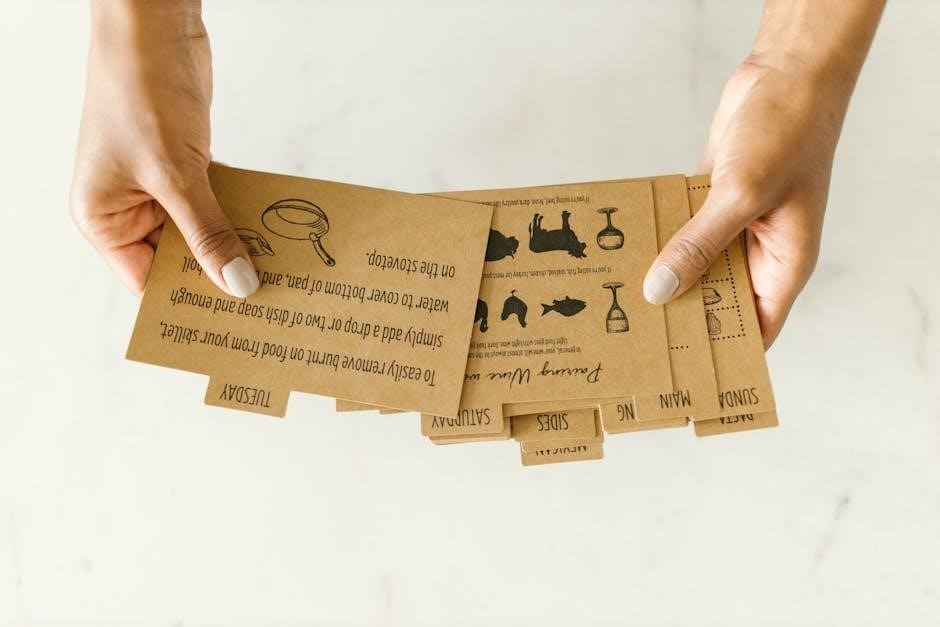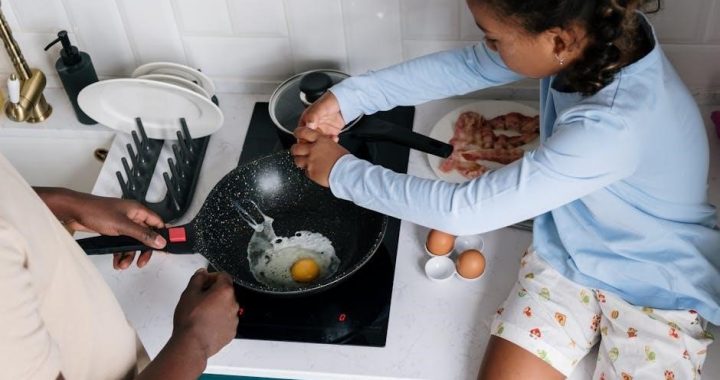Bosch induction hobs offer efficient, modern cooking solutions using electromagnetic fields for direct heat transfer. They are energy-efficient, feature sleek designs, and include advanced features like touch controls and child safety locks.
1.1 Overview of Induction Cooking Technology
Induction cooking uses electromagnetic induction to heat cookware directly, ensuring efficient energy transfer. This technology requires compatible cookware with ferromagnetic bases, such as cast iron or stainless steel. Unlike traditional methods, induction hobs heat the pan itself, not the stovetop, making cooking faster and more energy-efficient. The process is safe, as the hob only activates when cookware is present, and it automatically shuts off when removed.
1.2 Benefits of Using a Bosch Induction Hob
Bosch induction hobs offer superior energy efficiency, faster cooking times, and precise temperature control. They heat cookware directly, reducing energy loss and ensuring quicker results. The sleek, modern design integrates seamlessly into any kitchen, while the smooth glass surface is easy to clean. Enhanced safety features, such as automatic shut-off and child safety locks, provide peace of mind. Bosch induction hobs also promote eco-friendly cooking with minimal heat radiation, making them a smart choice for modern households.

Understanding Your Bosch Induction Hob Components
Bosch induction hobs feature a sleek glass surface with cooking zones, a control panel with intuitive buttons, and advanced sensors for precise heat control and safety.
2.1 Key Parts of the Induction Hob
The Bosch induction hob consists of a glass ceramic surface with marked cooking zones, a central control panel with touch buttons, and sensors for detecting cookware. The cooling fan ensures optimal temperature regulation, while the electronic control unit manages power distribution. Additional features include LED indicators for active zones and a child safety lock. These components work together to provide efficient, safe, and precise cooking experiences.
2.2 Control Panel and Function Buttons
The Bosch induction hob features a sleek, intuitive control panel with touch-sensitive buttons. These buttons allow you to adjust power levels, select cooking zones, and activate special functions like the child safety lock. The panel also includes a central power button and +/- controls for precise heat adjustment. LED indicators provide clear feedback on active zones and settings, ensuring easy operation. The buttons are responsive and designed for seamless navigation during cooking.
2.3 Cooking Zones and FlexInduction Technology
Bosch induction hobs feature multiple cooking zones, each with independent controls for precise heat management. The innovative FlexInduction technology allows you to combine adjacent zones into a single large cooking area, ideal for oversized cookware. This technology automatically detects the size and shape of your pan, ensuring efficient energy use. It also enables dynamic cooking with flexible placement of pots and pans, enhancing culinary versatility and convenience for modern kitchens.
Safety Precautions and Instructions
Always follow safety guidelines to ensure safe operation. Keep children away, avoid overheating, and use compatible cookware. Regularly clean and inspect the hob for damage.
3.1 General Safety Guidelines
Always ensure the hob is installed by a qualified technician. Keep children away from the cooking area. Avoid placing combustible materials near the hob. Use cookware with a flat, heavy base and ensure it is compatible with induction. Never leave cooking unattended or allow the hob to overheat. Keep the hob surface clean and dry to prevent accidents. Avoid spills and splashes, as they can cause damage. Regularly inspect the hob for wear and tear.
3.2 Child Safety Lock Activation and Deactivation
To activate the child safety lock on your Bosch induction hob, press and hold the lock button for three seconds. The indicator light will illuminate, signaling that the lock is engaged; To deactivate, repeat the same process. This feature ensures the hob cannot be accidentally turned on, providing enhanced peace of mind for families with children. Always refer to your user manual for specific instructions, as procedures may vary slightly by model.
3.3 Fire and Burn Prevention Tips
Prevent fires by never leaving cooking unattended and keeping flammable materials away from the hob. Always use cookware with a heavy, stable base to avoid spills. If a spill occurs, turn off the zone and clean it immediately. Never place hot pans on unprotected surfaces. Regularly inspect cords and connections for damage. Ensure the hob is installed according to Bosch’s guidelines to prevent overheating. Always follow recommended power levels to avoid excessive heat buildup.

Installation and Connection Requirements
Ensure professional installation adheres to local regulations, proper ventilation, and electrical supply specifications to guarantee safe and efficient operation of your Bosch induction hob.
4.1 Statutory Requirements for Installation
Ensure installation complies with local building codes, electrical safety standards, and regulations. Hire a certified professional to install the hob, adhering to IEE regulations and CE marking requirements. Proper installation ensures compliance with safety standards, warranty validity, and optimal performance. Always follow manufacturer guidelines and local authority specifications to avoid legal or safety issues.
4.2 Ventilation Recommendations
Proper ventilation is crucial for efficient operation and safety. Install an extractor hood or ducted ventilation system to remove heat, moisture, and cooking odors. Ensure the ventilation system is ducted outside rather than recirculating air. Maintain a gap of at least 50mm between the hob and any overhead cupboards. Operate the ventilation system during and after cooking to prevent condensation buildup and ensure a safe cooking environment.
4.3 Electrical Connection and Power Requirements
Your Bosch induction hob requires a dedicated 220-240V, 50Hz electrical supply. Use a 3-core cable with a minimum 6mm² cross-sectional area for safe connection. Ensure the circuit includes a 30mA RCD for protection. Avoid using extension cords, as they may cause power loss or safety hazards. Always consult a licensed electrician to ensure compliance with local electrical regulations and manufacturer guidelines for a secure installation.
Operating Your Bosch Induction Hob
Operate your Bosch induction hob by using the intuitive touch controls. Select zones, adjust power levels, and utilize features like AutoChef and timers for precise cooking control.
5.1 Initial Setup and First Use
Begin by unpacking and placing your Bosch induction hob on a stable, heat-resistant surface. Ensure proper installation by a certified technician, adhering to the user manual. Before first use, clean the hob with a damp cloth and mild detergent. Turn on the hob and check for any error messages. Start with a simple test, such as boiling water, using compatible cookware. Familiarize yourself with the controls and settings to ensure a smooth cooking experience.
5.2 Selecting Cooking Zones and Power Levels
Selecting the right cooking zone and power level ensures efficient cooking. Choose a zone that matches your cookware size for optimal energy use. Use the control panel to activate zones and adjust power levels (typically 1-9). Lower levels are ideal for simmering, while higher levels suit boiling or frying; Experiment with settings to find the perfect heat for your dish, ensuring even cooking and energy efficiency.
5.3 Using the AutoChef and Timer Functions
The AutoChef function automatically adjusts heat to maintain consistent cooking temperatures, preventing overheating. Activate it by selecting the cooking zone and desired temperature. The Timer function allows you to set cooking durations (1-99 minutes). Press the Timer button, choose the zone, and set the time. Use these features together for precise control, especially for simmering or frying. This ensures dishes are cooked perfectly without constant monitoring, enhancing your cooking experience.

Cooking Techniques and Tips
Optimize induction cooking by using magnetic cookware and adjusting heat levels gradually. Utilize proper utensils to prevent scratches and maintain a clean surface for efficient performance.
6.1 Choosing the Right Cookware for Induction
Select cookware made from ferromagnetic materials like cast iron or stainless steel, as these work best with induction. Avoid aluminum or copper cookware unless they have a magnetic base. Ensure the cookware has a flat, smooth bottom for even heat distribution. Use a magnet to test compatibility—ferromagnetic materials will attract it. Always avoid using glass, ceramic, or non-ferrous metals, as they won’t heat up on an induction hob. Proper cookware selection ensures efficient and safe cooking.
6.2 Adjusting Heat Levels for Different Dishes
Adjust heat levels by using the touch controls to select the appropriate power setting for your dish. For delicate tasks like simmering, use lower levels (1-3). For boiling or frying, opt for medium to high levels (4-8). Use the boost function for high-heat searing or rapid boiling. Experiment with gradual adjustments to ensure even cooking. This precise control allows you to tailor heat output to suit various cooking techniques and ingredients, optimizing results for every meal.
6.3 Energy-Saving Cooking Practices
Optimize energy use by selecting the right cookware size and material, as this enhances heat transfer. Use flat-bottomed, induction-compatible pots to maximize efficiency. Avoid overheating by preheating only when necessary. Utilize the timer function to prevent prolonged cooking. Lower power levels for simmering or keeping food warm. These practices reduce energy consumption while maintaining performance, making your Bosch induction hob an eco-friendly choice for everyday cooking.

Advanced Features of Bosch Induction Hobs
Bosch induction hobs offer cutting-edge features like FlexInduction zones, automatic pan recognition, and smart sensors for precise heat control and energy efficiency, enhancing your cooking experience.
7.1 FlexInduction and Multi-Zone Cooking
Bosch’s FlexInduction technology allows for flexible cooking zones, enabling you to use multiple pots or one large cookware across the entire surface. The hob automatically detects the size and shape of your cookware, ensuring efficient energy use. Multi-zone cooking allows you to combine zones for larger dishes or separate them for simultaneous cooking. This feature enhances flexibility and optimizes cooking efficiency, making meal preparation faster and more convenient.
7.2 Automatic Pan Recognition and Adjustment
Bosch induction hobs feature automatic pan recognition, which detects the presence and size of cookware. The hob adjusts its cooking zone and power output to match the pan’s dimensions, ensuring efficient energy use. This smart feature prevents overheating and optimizes cooking performance. When a pan is removed, the zone automatically switches off, enhancing safety and energy efficiency. This intelligent adjustment ensures consistent heat distribution for perfect cooking results every time;
7.3 Smart Cooking Sensors and Automation
Bosch induction hobs are equipped with advanced smart cooking sensors that continuously monitor the cooking process. These sensors automatically adjust heat levels to prevent overheating and ensure precise temperature control. The automation feature allows for preset settings for specific dishes, such as searing meat or simmering sauces. This intelligent system simplifies cooking, delivering consistent results while reducing manual intervention. It enhances safety and efficiency, making it ideal for both novice and experienced cooks.

Maintenance and Cleaning
Regular cleaning ensures optimal performance. Use a damp cloth for daily wipes. Avoid harsh chemicals and abrasive materials. Check cooling vents for blockages to maintain efficiency and longevity.
8.1 Daily Cleaning and Care Tips
For daily maintenance, wipe the induction hob with a damp cloth after use. Avoid harsh chemicals or abrasive cleaners, as they can damage the glass surface. Use a microfiber cloth for streak-free cleaning. For tougher stains, mix water and white vinegar on the surface, let it sit, then wipe clean. Regularly check and clean the cooling vents to ensure proper airflow; Dry the hob thoroughly after cleaning to prevent water spots.
8.2 Deep Cleaning the Cooking Surface
To deep clean the cooking surface, apply a small amount of ceramic cooktop cleaner or baking soda mixed with water to form a paste. Gently scrub the surface with a soft, non-abrasive cloth or sponge. Rinse thoroughly with a damp cloth to remove residue. For stubborn stains, let the paste sit for 15–20 minutes before wiping clean. Avoid using harsh chemicals or scrubbers to prevent scratches.
8.3 Maintaining the Cooling Fan and Vents
Regularly clean the cooling fan and vents to ensure proper airflow and prevent overheating. Use a soft cloth or brush to remove dust and debris from the vents. Avoid blocking the vents, as this can reduce efficiency. Check and clean the fan filter monthly, and ensure the hob is installed in a well-ventilated area. Proper maintenance helps the cooling system function effectively, prolonging the hob’s lifespan and performance.

Troubleshooting Common Issues
Identify common problems like error codes or unresponsive controls. Refer to the user manual for solutions or reset the hob. Contact Bosch support if issues persist.
9.1 Error Codes and Their Solutions
Bosch induction hobs display error codes like E0, E1, or E2, indicating issues such as overheating or sensor malfunctions. Refer to the user manual for specific code meanings. For E0, ensure the hob is cool and clean. For E1, check cookware compatibility or reset the hob. If problems persist, contact Bosch customer support for professional assistance to resolve the issue effectively.
9.2 Resolving Unresponsive Cooktop Issues
If your Bosch induction hob is unresponsive, check the power supply and ensure the circuit breaker hasn’t tripped. Verify that the cookware is compatible and properly placed. Clean the cooktop surface, as residue can interfere with sensor functionality. Deactivate the child safety lock if activated. If issues persist, reset the hob by turning it off and on. Contact Bosch support for further assistance if the problem remains unresolved.
9.3 Addressing Overheating or Noise Problems
If your Bosch induction hob overheats or makes unusual noises, ensure proper ventilation and check for blockages in the cooling vents. Verify that cookware is compatible and correctly sized. Excessive noise may indicate improper placement or unsuitable cookware. Allow the hob to cool down before restarting. If issues persist, refer to the user manual or contact Bosch customer support for professional assistance.

Frequently Asked Questions (FAQs)
This section provides answers to common queries about Bosch induction hobs, including compatibility, troubleshooting, and maintenance tips for optimal performance and user satisfaction.
10.1 Compatibility of Cookware
For Bosch induction hobs, cookware must be ferromagnetic. Materials like cast iron, stainless steel, and carbon steel work best. Non-ferrous materials like aluminum, copper, or glass are incompatible unless they have a ferromagnetic base. Always check if a magnet adheres to the cookware’s bottom to confirm compatibility. Using the right cookware ensures efficient heat transfer and optimal performance of your Bosch induction hob.
10.2 Understanding Power Levels and Cooking Zones
Bosch induction hobs feature multiple power levels (typically 1-9) for precise heat control. Each cooking zone operates independently, allowing simultaneous cooking at different power settings. The zones are clearly marked on the hob surface, indicating their size and position. Some models offer flexible zones that can combine into larger cooking areas, enhancing versatility. Adjusting power levels ensures optimal heat distribution for various cooking techniques, from gentle simmering to high-heat searing.
10.3 Resetting the Induction Hob
To reset your Bosch induction hob, switch it off and unplug it from the power source. Wait for 30 seconds to allow the system to reset. Plug it back in and turn it on. This process restores default settings and resolves minor glitches. If issues persist, consult the user manual or contact Bosch support for further assistance.

Environmental and Energy Efficiency
Bosch induction hobs are designed with energy efficiency in mind, reducing energy consumption and environmental impact through advanced technology and eco-friendly manufacturing processes.
11.1 Energy-Saving Benefits of Induction Cooking
Induction cooking with Bosch hobs offers significant energy-saving benefits. It directly transfers energy to cookware, minimizing heat loss and reducing overall power consumption. This method uses up to 50% less energy compared to traditional gas or electric stoves, lowering electricity bills and environmental impact. The precise heat control and faster cooking times further enhance efficiency, making Bosch induction hobs a cost-effective and eco-friendly choice for modern kitchens.
11.2 Eco-Friendly Features of Bosch Induction Hobs
Bosch induction hobs are designed with eco-conscious features to minimize environmental impact. They use recyclable materials and energy-efficient technology, reducing carbon emissions. The hobs’ smart sensors optimize energy use, while automatic shut-off prevents unnecessary power consumption. Bosch also adheres to strict environmental standards, ensuring sustainable manufacturing processes. These features make Bosch induction hobs a greener alternative for eco-minded households, aligning with global efforts to reduce energy consumption and promote sustainability.
11.3 Reducing Carbon Footprint
Bosch induction hobs contribute to a reduced carbon footprint by using energy-efficient technology that minimizes power consumption. Their high efficiency ensures less energy is wasted, lowering overall carbon emissions. Additionally, induction cooking typically uses up to 50% less energy than traditional gas or electric stoves. By choosing Bosch, consumers support sustainable practices, aligning with global efforts to combat climate change and promote environmentally responsible living.
Bosch induction hobs offer efficient, safe, and eco-friendly cooking. Regular maintenance ensures optimal performance. Enjoy a sustainable and energy-efficient culinary experience with Bosch technology.
12.1 Final Tips for Optimal Use
To maximize efficiency, always use compatible cookware and adjust power levels based on dish requirements. Clean the hob regularly to maintain performance. Utilize the timer and sensor functions for precise cooking. Avoid overheating by monitoring temperatures. Store the hob in a dry, cool place when not in use. Refer to the manual for specific care instructions to ensure longevity and energy efficiency.
12.2 Importance of Regular Maintenance
Regular maintenance ensures your Bosch induction hob performs optimally and lasts longer. Clean the surface daily with a damp cloth and mild detergent to prevent residue buildup. Deep clean the cooktop and vents periodically to maintain airflow. Inspect and replace worn-out parts promptly. Always refer to the user manual for specific care instructions tailored to your model. Proper upkeep prevents malfunctions and ensures safe, efficient cooking.

Resources for Further Assistance
For further assistance, visit the Bosch official website for user manuals and troubleshooting guides. Contact Bosch customer support for help. Explore YouTube tutorials for demonstrations.
13.1 Accessing Bosch User Manuals
To access Bosch induction hob user manuals, visit the official Bosch website. Use the search bar to find your specific model number. Download the PDF manual, available in multiple languages, for detailed instructions on installation, operation, and troubleshooting. The manual also includes safety guidelines and warranty information. Regularly check for updates to ensure you have the latest version for optimal performance and safety.
- Visit the Bosch website: www.bosch-home.com.
- Enter your model number in the search bar.
- Download the PDF manual for free.
13.2 Contacting Bosch Customer Support
For assistance with your Bosch induction hob, contact customer support through their official website or phone. Visit the Bosch website and navigate to the “Support” section. Use the contact form, live chat, or call the provided number. Be prepared to provide your model number and a detailed description of your issue. Representatives are available during business hours to address queries, repairs, or maintenance needs.
- Phone: Check the Bosch website for regional contact numbers.
- Email: Use the contact form on the Bosch website.
- Live Chat: Available on the Bosch support page.
13.3 Recommended YouTube Tutorials
For visual guidance, Bosch recommends exploring YouTube tutorials specifically designed for induction hob users. Official Bosch channels and trusted home appliance reviewers offer step-by-step guides. Search for topics like “Bosch induction hob installation,” “cooking techniques,” or “troubleshooting common issues.” Channels like Bosch Home Appliances and Induction Cooking Tips provide detailed content. Subscribe to these channels for the latest updates and tips to maximize your hob’s performance.
- Bosch Home Appliances: Official tutorials and demos.
- Induction Cooking Tips: Practical cooking advice.
- Smart Home Solutions: Advanced feature guides.
